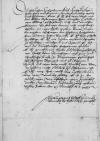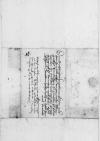Ewer F(urstliche) D(urchlauch)t hab wyr negst mit dem edlen, gestrengen hern Achatius von Zehmen (Achacy Cema) (*ca. 1485 – †1565), 1517-1531 Chamberlain of Pomerania, 1531-1546 Castellan of Gdańsk (Danzig), 1545-1546 Voivode of Kulm (Chełmno), 1546-1565 Voivode of Marienburg (Malbork) (SBPN 1, p. 194-195; ORACKI 1984, p. 38-39; Urzędnicy 5/2, p. 198; PSB 4, p. 325-326)⌊danczker castellanAchatius von Zehmen (Achacy Cema) (*ca. 1485 – †1565), 1517-1531 Chamberlain of Pomerania, 1531-1546 Castellan of Gdańsk (Danzig), 1545-1546 Voivode of Kulm (Chełmno), 1546-1565 Voivode of Marienburg (Malbork) (SBPN 1, p. 194-195; ORACKI 1984, p. 38-39; Urzędnicy 5/2, p. 198; PSB 4, p. 325-326)⌋ / vom Elbing (Elbląg), city in northern Poland, Pomerania, on the Vistula Lagoon, one of the three Great Prussian Cities (beside Gdańsk (Danzig) and Thorn (Toruń)) which had representatives in the Prussian Council; member of the Hanseatic League⌊ElbingElbing (Elbląg), city in northern Poland, Pomerania, on the Vistula Lagoon, one of the three Great Prussian Cities (beside Gdańsk (Danzig) and Thorn (Toruń)) which had representatives in the Prussian Council; member of the Hanseatic League⌋ / cf. Ioannes DANTISCUS & Achatius von ZEHMEN (CEMA) to Albrecht I von Hohenzollern-Ansbach Elbing (Elbląg), before 1535-11-12, CIDTC IDL 6910, letter lost⌊geschrybenn(n)cf. Ioannes DANTISCUS & Achatius von ZEHMEN (CEMA) to Albrecht I von Hohenzollern-Ansbach Elbing (Elbląg), before 1535-11-12, CIDTC IDL 6910, letter lost⌋, / auch was vonothen entpoten. / So hab wÿr dennoch nicht mocht nachlassen, / so wyr dÿsen unsern kamer jungen an unsern schwager, den achbarn, hochgelertn hern doctorn Johann Reyneck (†1535), the second husband of Dantiscus' sister Anna; doctor of both canon and civil law; councillor to Duke Albrecht von Hohenzollern (BORAWSKA 1984, p. 179-180, 203; GÜNTHER 1907, p. 365)⌊Johan ReyneckJohann Reyneck (†1535), the second husband of Dantiscus' sister Anna; doctor of both canon and civil law; councillor to Duke Albrecht von Hohenzollern (BORAWSKA 1984, p. 179-180, 203; GÜNTHER 1907, p. 365)⌋, E(wer) D(urchlauch)t rath, / geschickt, dÿ selbtige E(wer) D(urchlauch)t mit dÿsem unsernn(n) schreyben zu besuchen, / wunschend und byttend, E(wer) D(urchlauch)t und der durchlauchtn, hochgebornen Dorothea von Oldenburg (*1504 – †1547), Duchess in Prussia (1526-1547); first wife of Albrecht I von Hohenzollern-Ansbach, Duke in Prussia, daughter of Frederic I von Gottorp, King of Denmark, and Anna von Hohenzollern⌊furstinDorothea von Oldenburg (*1504 – †1547), Duchess in Prussia (1526-1547); first wife of Albrecht I von Hohenzollern-Ansbach, Duke in Prussia, daughter of Frederic I von Gottorp, King of Denmark, and Anna von Hohenzollern⌋, E(wer) D(urchlauch)t gemahel, / mit beyder furstlichem geschlecht / von Gotthe dem almechtigen / vyl gnad und christlich(e)s frieds in langweriger gesuntheÿt, gluckseligen regiment und zu nhemen. /
Sunst hab wyr das malh, / nemlich von newen zeytung, / nicht sunders zu schreÿben. / So E(wer) D(urchlauch)t was hett, / wolde uns myttheÿlenn(n), / das wir umb dÿ selbtig E(wer) D(urchlauch)t, in der gunst wyr uns befelhenn(n), / gern freuntlich wollen vordienen(n). /
 GStA, PK, HBA, C 2, No 97, f. 1v
GStA, PK, HBA, C 2, No 97, f. 1v  GStA, PK, HBA, C 2, No 97, f. 1r
GStA, PK, HBA, C 2, No 97, f. 1r 
